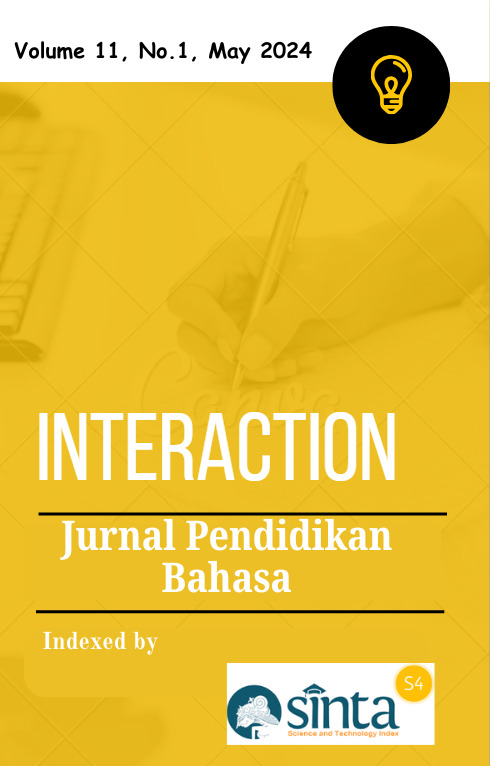The Effect of RAP Strategy in Teaching Reading
Abstract
RAP (Read, Ask, and Put) is a strategy that instructs students to focus their reading on a particular section of the text, consider the main idea and supporting ideas of the paragraph or passage, and then explain it in their own words. This study aims to determine the achievement of fourth-year students at Gontor for girls 2nd campus in reading comprehension using the RAP strategy since the researchers found that their reading comprehension is still low. This research used a quantitative experimental method with an experimental non-equivalent control group design. The population in this study were all fourth-year students of Gontor for girls 2nd campus with 79 students and used probability sampling which is simple random sampling. The method used in data collection is the test method and is complemented by some documentation. For the data analysis, it used the formula SPSS 22. This study concluded that the use of the RAP strategy in teaching reading comprehension on reading subjects proved effective with the formula-test acquisition value of Sig.(2.tailed) 0.009 < 0.05. Based on the conclusion, the researcher provided suggestions, they are (1) the RAP Strategy is very likely to be used to teach the reading subject to students because the students try to think critically and will understand the text with comprehension; (2) it is hoped that teachers will develop and try to apply the RAP strategy in teaching reading. Thus, the students can independently find the main idea and use their prior knowledge of vocabulary
Downloads
References
Brown, H Douglas. (2015). Teaching by Principles. California: Longman.
Patel, F. (2008). English Language Teaching (Method, Tools, and Technique). Jaipur: Sunrise Publishers & Distirbutors.
Lai, A. F., Chen, C. H., & Lee, G. Y. (2019). An augmented reality-based learning approach to enhancing students’ science reading performances from the perspective of the cognitive load theory. British Journal of Educational Technology, 50(1), 232–247. https://doi.org/10.1111/bjet.12716.
Szanto, B. (2020). Reading and Writing Comprehension in the Mother Tongue in the Romanian National Assessment – Objectives, Tests, Results. Technium Social Science Journal, 9. https://doi.org/https://doi.org/10.47577/tssj.v9i1.933.
Asna, & Mimi. (2016). Peningkatan Hasil dan Kemampuan Membaca Intensif Siswa Kelas IV pada Pembelajaran Bahasa Indonesia dengan Model Pembelajaran Word Square di SD Negeri 27 Batang Anai. Jurnal Konseling Dan Pendidikan, 4(2), 74 – 78. https://doi.org/https://doi.org/10.29210/166%y.
Pertiwi, I. N., Sumarno, & Dwi, A. (2019). Pengaruh Model Make A Match Berbantu Media Kartu Bergambar terhadap Kemampuan Membaca dan Menulis. MIMBAR PGSD Undiksha, 7(3), 261–270. https://doi.org/http://dx.doi.org/10.23887/jjpgsd.v7i3.19412
Caldwell, J.S. (2008). Comprehension Assessment: A Classroom Guide. New York: The Guildford Press.
Harmer, J. (2007). How to Teach English. Longman : Oxford University Press.
Sudarmawan, I.K.A. (2021). Using RAP Strategy to Teach Reading Comprehension in EFL Class. INDONESIAN JOURNAL OF EDUCATIONAL RESEARCH AND REVIEW, 4(1), 150-155. http://dx.doi.org/10.23887/ijerr.v4i1
Wikandari, Y. (2022). The Effectiveness of RAP Strategy in Teaching Reading Comprehension. Channing: Journal of English Language Education and Literature, 7(2), 47-54.
Baba, A., & Kuliahana, A. (2022). The Effectiveness of The Read-Ask-Paraphrase (RAP) Strategy To Improve Students’ Reading Comprehension. Datokarama English Education Journal, 3(1). https://doi.org/10.24239/dee.v1i1.46
Apriyani, M., & Almunawaroh, N.F. (2019). Teaching Reading Comprehension by Using RAP (Read-Ask-Put). English Empower, 4(2). Retrieved from: https://www.ejournal.unitaspalembang.ac.id/index.php/eejll/article/view/144/118
Hagaman,T. P.,Luschen, K.,Reid.R. (2010). The Rap on Reading comprehension: Teaching exceptional children. Retrieved from: https://faculty.unlv.edu/rebelinduction/I nstructional_Practices_files/The%20Paraphrasing%20Strategy%20325T%20Website.pdf
Hughes,C. A (2011). Effective Instructional Design and Delivery for Teaching Task-Specific Learning Strategies to students with Learning Disabilities. Focus on Exceptional Children, 44(2). https://doi.org/10.17161/foec.v44i2.6689
Nurhidayati., Jabu, B., & Latifa. A. (2021). Improving the Reading Comprehension of the Eight Year Student of SMP 5 Pinrang through RAP (Read-Ask-Put) Strategy. La Parole: Journal, 4(1). Retrieved from https://jurnal.umpar.ac.id/index.php/laparole/article/view/767
Healy, C. (2002). Reading: what the expert say. Parent Educational Advocacy Training Center. Retrieved from http://www.peatc.org/Fact%20Sheets/reading.pdf
Khand, Z. (2004). Teaching reading skills: Problems and suggestion. Retrieved from: http://www.bzu.edu.pk/jrlanguages/Vol -5%202004/Ziauddin%20Khand-4.pdf
Astiantih, S., Hamid, L. O. M.I., Yetty., & Sofyan. W. N. P. (2022). Improving Reading Comprehension by Using Experience Text Relationship (ETR). ELS Journal on Interdisciplinary Studies in Humanities, 5(2) https://doi.org/10.34050/elsjish.v5i2.21150
Triani, F & Jufri. (2018). Using Experience Text Relationship (ETR) in Teaching Reading Recount Text to Senior High Schools’ Students. Journal of English Language Teaching, 7 (4) https://doi.org/10.24036/jelt.v7i4
Grabe, W and F. L, Stoller. (2002). Teaching and Researching Reading. England: Pearson Education
Graham, Lorraine & Bellert, Anne. (2007). Effective Reading Comprehension Instruction for Students with Learning Disabilities. Australian Journal of Dyslexia & Specific Learning Disabilities. 2:
Sugiyono. (2017). Metode Penelitian Kuantitatif, Kualitatif, dan R&D (26th ed.). Alfabeta.
Syaid, N. (2018). The Students Personality Based on the Reading Strategy Used. EXPOSURE: JURNAL PENDIDIKAN BAHASA INGGRIS, 7(2), 192-204.
Mahmudi, Ihwan. (2020). Evaluasi Pendidikan. Sleman : Lintang Book.
Que, S.R & Wakim, V.A. (2020). Using RAP (Read, Ask, Put) Strategy to Improve Students’ Ability in Reading Comprehension at Class VII of SMP Negeri 2 Dobo. MATAI International Journal of Language Education, 1(1) https://doi.org/10.30598/matail.v1i1.2770
Afriadeni, M., Eryansyah., Inderawati. R. (2021). Increasing Reading Comprehension and Summary Writing Achievement by Using RAP Strategy with 100 Famous Stories Application. (1) https://doi.org/10.25134/erjee.v10i1.5367




.png)



22.png)
